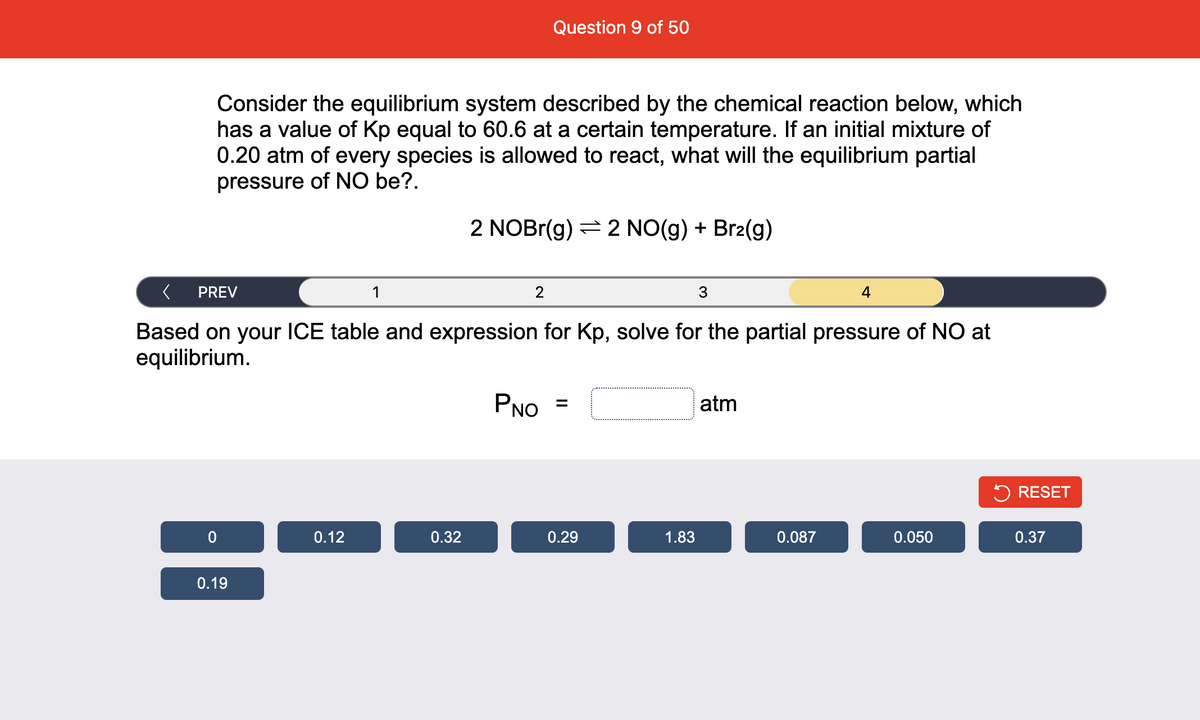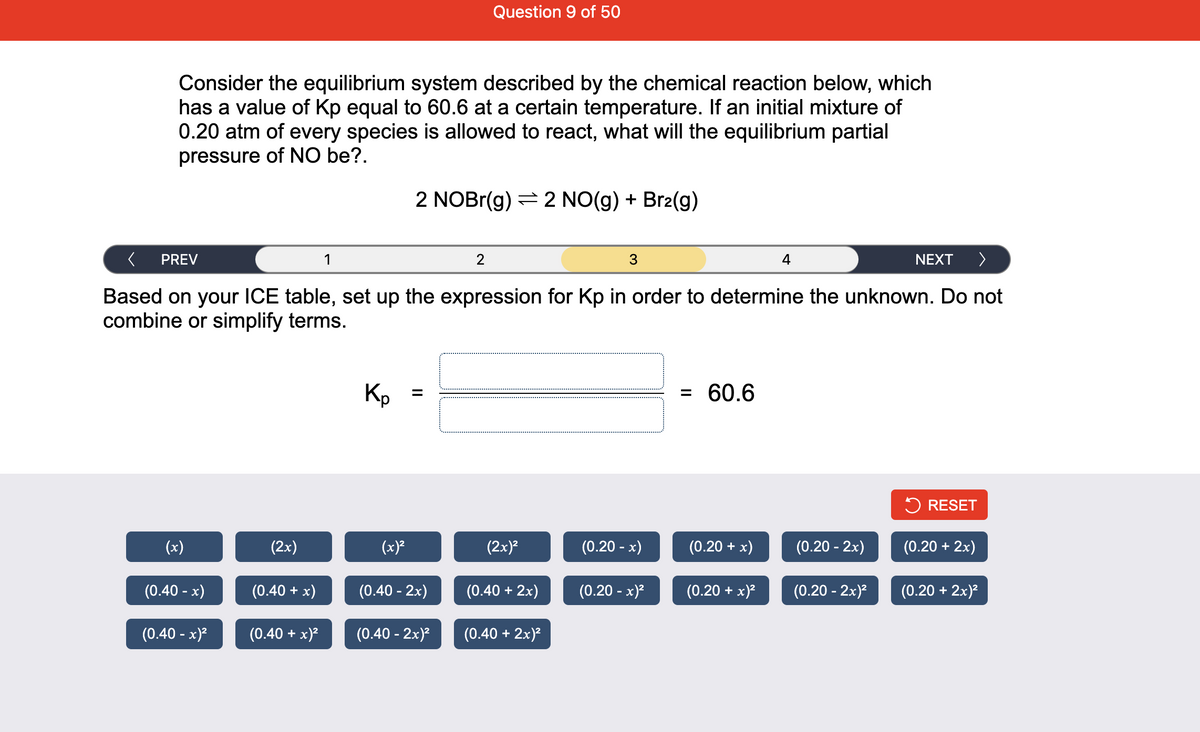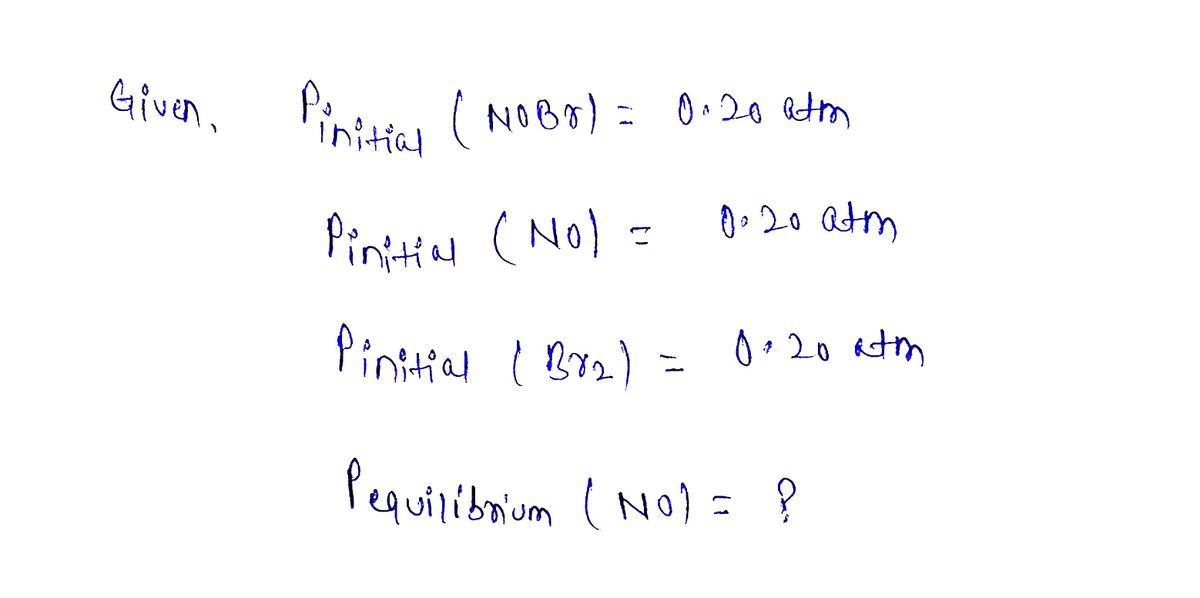Consider the equilibrium system described by the chemical reaction below, which has a value of Kp equal to 60.6 at a certain temperature. If an initial mixture of 0.20 atm of every species is allowed to react, what will the equilibrium partial pressure of NO be?. 2 NOBR(g) = 2 NO(g) + Br2(g) PREV 2 3 4 Based on your ICE table and expression for Kp, solve for the partial pressure of NO at equilibrium. PNO atm
Consider the equilibrium system described by the chemical reaction below, which has a value of Kp equal to 60.6 at a certain temperature. If an initial mixture of 0.20 atm of every species is allowed to react, what will the equilibrium partial pressure of NO be?. 2 NOBR(g) = 2 NO(g) + Br2(g) PREV 2 3 4 Based on your ICE table and expression for Kp, solve for the partial pressure of NO at equilibrium. PNO atm
Chemistry: Principles and Reactions
8th Edition
ISBN:9781305079373
Author:William L. Masterton, Cecile N. Hurley
Publisher:William L. Masterton, Cecile N. Hurley
Chapter12: Gaseous Chemical Equilibrium
Section: Chapter Questions
Problem 66QAP: Consider the equilibrium H2(g)+S(s)H2S(g)When this system is at equilibrium at 25C in a 2.00-L...
Related questions
Question

Transcribed Image Text:Question 9 of 50
Consider the equilibrium system described by the chemical reaction below, which
has a value of Kp equal to 60.6 at a certain temperature. If an initial mixture of
0.20 atm of every species is allowed to react, what will the equilibrium partial
pressure of NO be?.
2 NOBR(g) = 2 NO(g) + Br2(g)
PREV
1
2
3
4
Based on your ICE table and expression for Kp, solve for the partial pressure of NO at
equilibrium.
PNO
atm
%3D
5 RESET
0.12
0.32
0.29
1.83
0.087
0.050
0.37
0.19

Transcribed Image Text:Question 9 of 50
Consider the equilibrium system described by the chemical reaction below, which
has a value of Kp equal to 60.6 at a certain temperature. If an initial mixture of
0.20 atm of every species is allowed to react, what will the equilibrium partial
pressure of NO be?.
2 NOBr(g) = 2 NO(g) + Br2(g)
PREV
1
2
3.
4
NEXT
>
Based on your ICE table, set up the expression for Kp in order to determine the unknown. Do not
combine or simplify terms.
Kp
60.6
5 RESET
(x)
(2x)
(x)²
(2x)?
(0.20 - x)
(0.20 + x)
(0.20 - 2x)
(0.20 + 2x)
(0.40 - x)
(0.40 + x)
(0.40 - 2x)
(0.40 + 2x)
(0.20 - x)?
(0.20 + x)?
(0.20 - 2x)?
(0.20 + 2x)?
(0.40 - x)?
(0.40 + x)?
(0.40 - 2x)?
(0.40 + 2x)?
II
Expert Solution
Step 1

Step by step
Solved in 3 steps with 3 images

Knowledge Booster
Learn more about
Need a deep-dive on the concept behind this application? Look no further. Learn more about this topic, chemistry and related others by exploring similar questions and additional content below.Recommended textbooks for you

Chemistry: Principles and Reactions
Chemistry
ISBN:
9781305079373
Author:
William L. Masterton, Cecile N. Hurley
Publisher:
Cengage Learning

General Chemistry - Standalone book (MindTap Cour…
Chemistry
ISBN:
9781305580343
Author:
Steven D. Gammon, Ebbing, Darrell Ebbing, Steven D., Darrell; Gammon, Darrell Ebbing; Steven D. Gammon, Darrell D.; Gammon, Ebbing; Steven D. Gammon; Darrell
Publisher:
Cengage Learning

Chemistry: An Atoms First Approach
Chemistry
ISBN:
9781305079243
Author:
Steven S. Zumdahl, Susan A. Zumdahl
Publisher:
Cengage Learning

Chemistry: Principles and Reactions
Chemistry
ISBN:
9781305079373
Author:
William L. Masterton, Cecile N. Hurley
Publisher:
Cengage Learning

General Chemistry - Standalone book (MindTap Cour…
Chemistry
ISBN:
9781305580343
Author:
Steven D. Gammon, Ebbing, Darrell Ebbing, Steven D., Darrell; Gammon, Darrell Ebbing; Steven D. Gammon, Darrell D.; Gammon, Ebbing; Steven D. Gammon; Darrell
Publisher:
Cengage Learning

Chemistry: An Atoms First Approach
Chemistry
ISBN:
9781305079243
Author:
Steven S. Zumdahl, Susan A. Zumdahl
Publisher:
Cengage Learning

Chemistry
Chemistry
ISBN:
9781305957404
Author:
Steven S. Zumdahl, Susan A. Zumdahl, Donald J. DeCoste
Publisher:
Cengage Learning


Chemistry & Chemical Reactivity
Chemistry
ISBN:
9781133949640
Author:
John C. Kotz, Paul M. Treichel, John Townsend, David Treichel
Publisher:
Cengage Learning